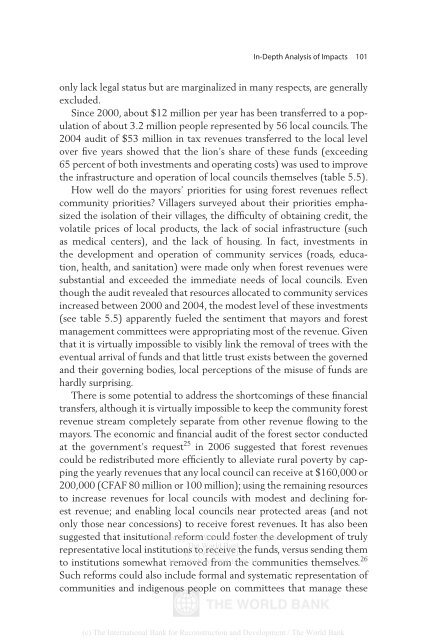The Rainforests of Cameroon - PROFOR
The Rainforests of Cameroon - PROFOR
The Rainforests of Cameroon - PROFOR
- No tags were found...
You also want an ePaper? Increase the reach of your titles
YUMPU automatically turns print PDFs into web optimized ePapers that Google loves.
In-Depth Analysis <strong>of</strong> Impacts 101only lack legal status but are marginalized in many respects, are generallyexcluded.Since 2000, about $12 million per year has been transferred to a population<strong>of</strong> about 3.2 million people represented by 56 local councils. <strong>The</strong>2004 audit <strong>of</strong> $53 million in tax revenues transferred to the local levelover five years showed that the lion’s share <strong>of</strong> these funds (exceeding65 percent <strong>of</strong> both investments and operating costs) was used to improvethe infrastructure and operation <strong>of</strong> local councils themselves (table 5.5).How well do the mayors’ priorities for using forest revenues reflectcommunity priorities? Villagers surveyed about their priorities emphasizedthe isolation <strong>of</strong> their villages, the difficulty <strong>of</strong> obtaining credit, thevolatile prices <strong>of</strong> local products, the lack <strong>of</strong> social infrastructure (suchas medical centers), and the lack <strong>of</strong> housing. In fact, investments inthe development and operation <strong>of</strong> community services (roads, education,health, and sanitation) were made only when forest revenues weresubstantial and exceeded the immediate needs <strong>of</strong> local councils. Eventhough the audit revealed that resources allocated to community servicesincreased between 2000 and 2004, the modest level <strong>of</strong> these investments(see table 5.5) apparently fueled the sentiment that mayors and forestmanagement committees were appropriating most <strong>of</strong> the revenue. Giventhat it is virtually impossible to visibly link the removal <strong>of</strong> trees with theeventual arrival <strong>of</strong> funds and that little trust exists between the governedand their governing bodies, local perceptions <strong>of</strong> the misuse <strong>of</strong> funds arehardly surprising.<strong>The</strong>re is some potential to address the shortcomings <strong>of</strong> these financialtransfers, although it is virtually impossible to keep the community forestrevenue stream completely separate from other revenue flowing to themayors. <strong>The</strong> economic and financial audit <strong>of</strong> the forest sector conductedat the government’s request 25 in 2006 suggested that forest revenuescould be redistributed more efficiently to alleviate rural poverty by cappingthe yearly revenues that any local council can receive at $160,000 or200,000 (CFAF 80 million or 100 million); using the remaining resourcesto increase revenues for local councils with modest and declining forestrevenue; and enabling local councils near protected areas (and notonly those near concessions) to receive forest revenues. It has also beensuggested that insitutional Delivered reform by <strong>The</strong> World could Bank foster e-library the to: development <strong>of</strong> truly<strong>The</strong> World Bankrepresentative local institutions IP : to 192.86.100.34 receive the funds, versus sending themto institutions somewhat Mon, removed 09 Nov from 2009 17:06:18 the communities themselves. 26Such reforms could also include formal and systematic representation <strong>of</strong>communities and indigenous people on committees that manage these(c) <strong>The</strong> International Bank for Reconstruction and Development / <strong>The</strong> World Bank
















